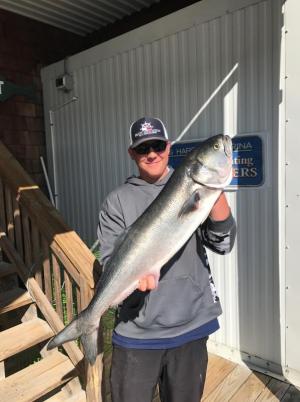The big blues came back to Delaware and were chewing up the pier and the beach at Cape Henlopen State Park. Tuesday saw great fishing, with poppers, metal lures and cut bunker all accounting for good catches. Wednesday, not so much.
I have no idea how long this will last, but I wouldn’t waste much time before getting down to the pier. Use poppers for the most explosive action or try a Hopkins metal lure if the fish aren’t chasing bait on the surface. If lures don’t work, break out some fresh bunker and soak that on the bottom.
Fewer numbers of big blues have been caught along the ocean beaches on the same lures and bait. You can cruise the beach looking for diving birds or pick a spot and soak some bunker until the fish pass by.
They are catching these blues in Cape Hatteras and the bays behind the islands as well as Virginia Beach and Ocean City, Md. There have been scattered reports of big blues as far north as Belmar, N.J. That is a pretty good distribution area and bodes well for the future.
On the not-so-bright side is the lack of flounder along the Delaware coast. As of Wednesday, only one had been caught out of Indian River Inlet, and it was only 16 inches and had to be released. The first keeper was caught from the Lewes-Rehoboth Canal.
The primary reason we had to cut the recreational catch was poor recruitment of the flounder stock. For the past six years, the spawning success of summer flounder has been poor, resulting in very few fish to replace those taken out of the population by fishermen and natural causes. Even if we had a banner spawn this year, it would take three to four years before those fish would be a catchable size. With such a slow start, I will be anxious to see how we do on flounder out in the ocean.
Black sea bass are a good news-bad news story. The good news is the population of black sea bass is as high as it has ever been. The bad news is this expanded population should equate to relaxed regulations for recreational fishermen. Unfortunately, the National Marine Fisheries Service decided to raise the commercial catch by 53 percent, while keeping the recreational quota at the same level as it was when they were trying to restore the stock. Can you say, we got screwed?!
The spring run of big rockfish in the Lower Delaware River and Upper Delaware Bay is just getting underway. It has been a slow pick of fish to 40 inches from the shoreline at Augustine Beach on down to the Red Can out of Woodland Beach. Fresh bunker has been the top bait. Most boat fishermen will anchor up and chunk with bunker while fishing baits at different levels from a few feet under the surface all the way to the bottom.
Small rockfish seem to be everywhere, from the upper reaches of the tidal creeks and rivers down the coast as far as Ocean City. Most are caught on bloodworms or small jigs.
I hope this is a positive sign for those of us who like to catch rockfish. The size of these fish would indicate they came from the 2014 or 2015 year class. It will be another four or five years before they reach 28 inches, but if we can maintain the same high numbers as we have now, the fishing could be off the charts.
Black drum action has gotten off to an early start with 20- to 30-pounders caught from the beach at Cape Henlopen and Broadkill Beach. Fresh clams have been the top bait.
On Tuesday, I picked up a supply of Dan’s Clans from his shop on Route 1 and headed to Broadkill Beach. The wind was a bit brisk out of the northeast as I let the air down on my tires, and when I crested the dune and saw the water, I knew it was going to be a tough afternoon.
The water was brown. Not a good color for most fishing endeavors. I started soaking clams on the incoming tide and had to change baits every 10 minutes as something chewed the clams off very quickly.
There were several other hopeful anglers on the beach, but I did not see anyone catch anything.
When the tide began to run out, my rigs began to be covered in that brown, hairy seaweed. Between the dirty water, abundant seaweed, lack of fish and hands that were frozen solid, I decided to call it a day.
Yeah, I know, I should have gone to the fishing pier and caught big bluefish. Well, there is always next time.





















































